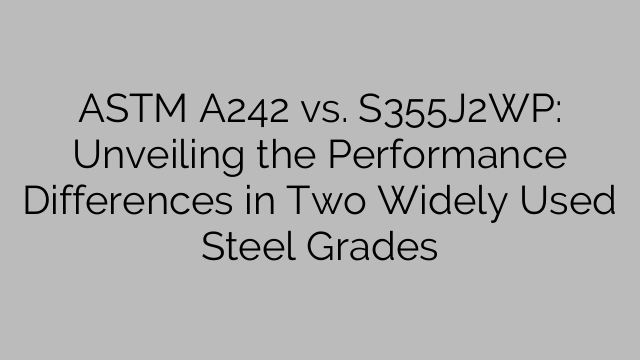ASTM A242 and S355J2WP are two popular steel grades used in various industries, particularly in construction and structural engineering. Both have their unique characteristics and offer different performance capabilities. To understand their differences, we need to delve into the composition, properties, and applications of each.
ASTM A242 is a high-strength low-alloy (HSLA) steel grade that primarily contains copper, chromium, and nickel. It offers excellent atmospheric corrosion resistance, making it suitable for outdoor applications such as bridges, buildings, and sculptures. The copper in A242 forms a protective oxide layer, commonly known as patina, which slows down the corrosion process and prolongs the structural life. The steel also has good weldability, formability, and tensile strength. These properties make it an ideal choice for structural elements subjected to harsh weather conditions.
On the other hand, S355J2WP is a weathering steel grade that contains phosphorus, copper, chromium, nickel, and other elements. Unlike ASTM A242, S355J2WP develops a distinctive patina on its surface when exposed to the atmosphere, acting as a protective layer against further corrosion. This unique characteristic eliminates the need for painting, resulting in lower maintenance costs. Additionally, S355J2WP offers high yield strength, excellent tensile strength, and good weldability, making it suitable for a wide range of applications, including bridges, façades, and structural components.
In terms of performance, ASTM A242 and S355J2WP both demonstrate exceptional resistance to atmospheric corrosion. However, there are some notable differences between the two. ASTM A242 has higher yield strength and ultimate tensile strength compared to S355J2WP. This makes A242 a more robust choice for structural elements subjected to high loads or demanding conditions. Additionally, its higher strength allows for thinner sections, resulting in reduced weight and cost-effectiveness.
On the other hand, S355J2WP showcases improved resistance to chloride-induced corrosion, making it suitable for applications in coastal or marine environments where exposure to saltwater or chlorides is significant. It also offers better impact toughness, making it more resilient against sudden shocks or vibrations.
Both ASTM A242 and S355J2WP have various applications in structural engineering and construction. ASTM A242 is commonly used in bridges, buildings, and structural components exposed to harsh weather conditions. Its high-strength properties and atmospheric corrosion resistance make it a reliable option for long-term durability. S355J2WP, on the other hand, is frequently employed in bridge construction, façades, and architectural elements where the aesthetically pleasing rust-colored surface is desired, while maintaining structural integrity.
Ultimately, the choice between ASTM A242 and S355J2WP depends on the specific requirements of the project and the environmental conditions it will face. Factors such as load-bearing capacity, exposure to corrosive elements, aesthetic preferences, and economic considerations should all be taken into account. Consulting with structural engineers or steel experts can provide valuable insights and help in selecting the most suitable steel grade for the intended application.
In conclusion, ASTM A242 and S355J2WP are two widely used steel grades that offer excellent atmospheric corrosion resistance. While A242 boasts higher strength and weldability, S355J2WP excels in its resistance to chlorides and impact toughness. Careful consideration of project requirements is essential in choosing between these grades to ensure optimal performance and durability.

